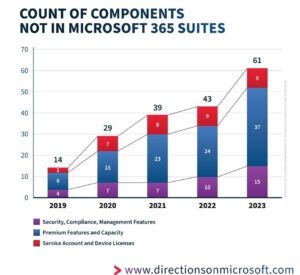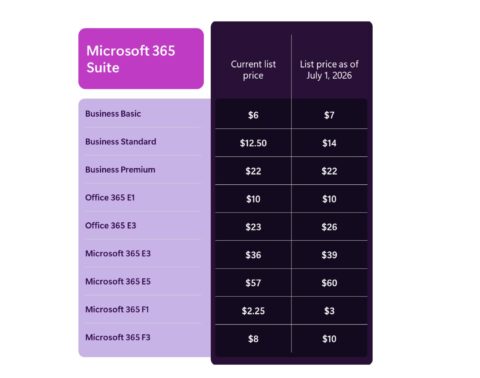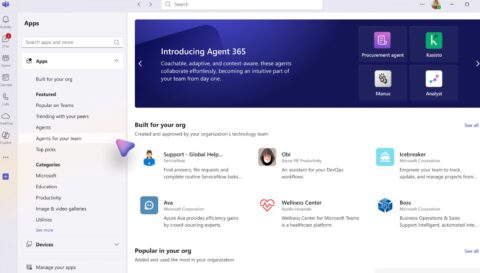Updated: April 8, 2024 (January 17, 2024)
BlogPaid add-ons to Microsoft 365 are multiplying rapidly. What's a customer to do?

When your company shells out more than $700 per user per year for Microsoft’s top-of-the-line E5 subscription, you would assume it would include everything you’d need. If you did, you’d likely be wrong.
Microsoft is making more and more new features and apps available as paid add-ons for Microsoft 365 customers. And like many parents and kids discover the hard way, when the expected batteries aren’t included with your new, pricey toy, no one is happy.
Directions on Microsoft has long tracked all the extra-cost add-ons to Microsoft 365 plans. These add-ons include features, apps, and licenses that may be needed above and beyond what’s standard in the $36 (USD) per user per month Microsoft 365 E3 and $57 per user per month Microsoft 365 E5 subscriptions. Examples of the some of these add-ons:
- Capabilities that might be needed to meet security, compliance and management needs, such as Defender Vulnerability Management, Priva Privacy Risk Management, and Microsoft 365 Cross Tenant User Data Migration;
- Premium capabilities beyond the base features included in Microsoft 365 suites, such as Microsoft 365 Copilot, Power BI Premium, and Teams Premium;
- Licenses for devices and service accounts not covered by the Microsoft 365 suites, such as Exchange Online Plan 2 (for shared mailboxes; Teams Shared Devices
In December 2019, Directions counted 14 such available add-ons. By December 2023, we found 61.
Add-ons: More than just per-user costs
These add-on services are not cheap, especially when purchased by customers who need hundreds or thousands of seats.
Copilot for Microsoft 365 is $30 per user per month. Teams Premium is $10 per user per month. The Intune Suite add-on to Plan 1 that includes all Plan 2 features, and all existing and forthcoming à la carte features, is $10 per user per month. Defender Vulnerability Management costs $2 per user per month on top of Microsoft Defender Endpoint P2 or $3 per user per month when licensed alone to use with a third-party endpoint detection and response product.
Plus, there are additional costs beyond just the add-ons themselves.
In the case of security add-ons, for instance, “Microsoft has created a dilemma no one is talking about: Who’s going to evaluate, implement, and manage all these new security tools inside Microsoft customer organizations?” noted Directions on Microsoft analyst Michael Cherry.
“Microsoft and other cloud vendors promised the cloud would help reduce IT costs, not just in terms of on-premises hardware and software, but also in terms of IT headcount. It now seems that the cloud is the cause of significant new costs, at least for security. The main cost will likely be to acquire the expertise, either through training or new hires of people with the necessary skills to understand how-to use these tools effectively,”
With Entra, the service formerly known as Azure Active Directory, organizations may encounter other issues they hadn’t anticipated.
“With the identity governance add-ons, it’s almost impossible to describe what each does,” said Directions on Microsoft analyst Wes Miller. “But CxOs are still gonna buy them.”
Will E7 save the day?
Some of the Directions on Microsoft analysts believe the current growth trajectory for Microsoft 365 is unsustainable and Microsoft may soon release a new high-end Microsoft 365 subscription tier — something like an “E7” which would include some of the extra-cost features. At the very least, a new tier that includes Microsoft 365 Copilot bundled in, seems almost inevitable, given Microsoft’s current obsession with all things AI and Copilots.
But other Directions analysts believe that Microsoft may stay the course with E5 as the Microsoft 365 high-end for a while longer. Last time Microsoft released an official number, Microsoft 365 E5 was deployed by only 12 percent of the Microsoft 365 installed base.
By holding the price line with E5 and continuing to roll out more optional add-ons, Microsoft officials may believe they can maximize average revenue per user while publicly claiming they are trying to help customers “do more with less.” In January 2024, for example, Microsoft added several new add-on Entra and Defender SKUs targeted specifically at frontline workers, which could save some companies money by enabling them to deploy feature-specific add-ons, rather than having to buy the full P1/P2 SKUs.
Related Resources
Is Microsoft 365 E7 waiting in the wings?
Services Increasingly Expanding Beyond Microsoft 365 Suites (Directions members only)















